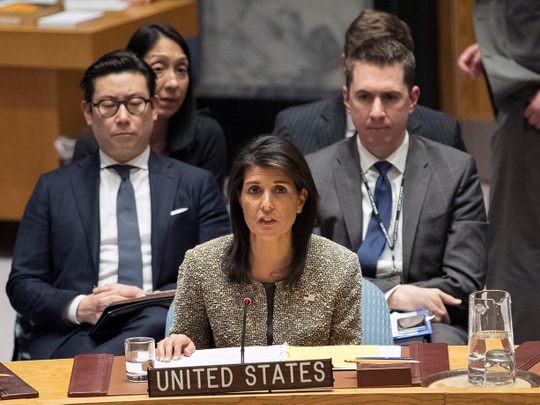
Seoul: The United States warned the North Korean leadership that it would be “utterly destroyed” if war were to break out, after Pyongyang test fired its most advanced intercontinental ballistic missile, putting the US mainland within range.
The Trump administration has repeatedly said all options were on the table in dealing with North Korea’s ballistic and nuclear weapons program, including military ones, but that it still prefers a diplomatic option.
Still, speaking at an emergency UN Security Council meeting, US ambassador Nikki Haley warned: “We have never sought war with North Korea, and still today we do not seek it. If war does come, it will be because of continued acts of aggression like we witnessed yesterday ... And if war comes, make no mistake, the North Korean regime will be utterly destroyed.”
Haley said the United States has asked China to cut off oil supply to North Korea, a drastic step that Beijing — the North’s neighbour and sole major trading partner — has so far refrained from doing. Trump and Chinese President Xi Jinping talked on the phone earlier on Wednesday.
“Just spoke to President Xi Jinping of China concerning the provocative actions of North Korea. Additional major sanctions will be imposed on North Korea today. This situation will be handled!” Trump wrote on Twitter.
Previous US administrations have failed to stop North Korea from developing nuclear weapons and a sophisticated missile program. Trump has also struggled to contain Pyongyang since he came to office in January.
Urging China to use its leverage on Pyongyang and promising more sanctions against North Korea are two strategies that have borne little fruit so far.
In a speech in Missouri about taxes, Trump, who has traded insults with the North in the past, referred to North Korean leader Kim Jong Un with a derisive nickname. “Little Rocket Man.
He is a sick puppy,” Trump said.
The latest missile was fired a week after Trump put North Korea back on a US list of countries it says support terrorism, allowing it to impose more sanctions.
United Nations political affairs chief Jeffrey Feltman met with North Korea’s Ambassador Ja Song Nam on Wednesday to tell him Pyongyang must “desist from taking any further destabilizing steps” after the country launched another ballistic missile.
North Korea, which conducted its sixth and largest nuclear bomb test in September, has tested dozens of ballistic missiles under Kim’s leadership in defiance of international sanctions.
Pyongyang has said its weapons programmes are a necessary defence against US plans to invade. The United States, which has 28,500 troops in South Korea as a legacy of the 1950-53 Korean War, denies any such intention.
Russia’s UN Ambassador Vassily Nebenzia called on North Korea on Wednesday to stop its missile and nuclear tests and for the United States and South Korea not to hold military drills in December as it would “inflame an already explosive situation.”
North Korea said the new missile soared to an altitude of about 4,475km — more than 10 times the height of the International Space Station — and flew 950km during its 53-minute flight.
It flew higher and longer than any North Korean missile before, landing in the sea near Japan. Missile experts said the new “Hwasong-15” missile theoretically gave North Korea the ability to hit the United States, including the East Coast, although it was not clear whether it could carry a nuclear weapon.
Photos released by North Korean state media appeared to show a missile being positioned on the launch site by a mobile vehicle, designed to allow the missile to be fired from a wider number of areas to prevent it being intercepted before launch.
Kim is shown laughing and smiling with officials both next to the missile as it is readied, and in a control booth. The launch itself shows the missile lifting off amid smoke and fire, with Kim watching from a field in the distance.
US intelligence analysts have concluded from satellite and other data that the test missile was fired from a fixed position, not a mobile launcher, three US officials said on Wednesday.
Two of the officials, who both follow developments in North Korea closely, said that while the test appears to demonstrate a more powerful North Korean solid-fuel propulsion system, especially in its second stage rocket, it is far from clear that North Korea has developed a weapon that could reliably deliver a nuclear weapon to the US mainland.
The two officials also said the North has not proved it has an accurate guidance system for an intercontinental ballistic missile or a re-entry vehicle capable of carrying a nuclear warhead and surviving a return from space through Earth’s atmosphere.
The photos revealed some developments in missile technology, including a larger diameter, which could allow the missile to carry a larger warhead and use a more powerful engine, said David Wright of the Union of Concerned Scientists, a US-based non-profit science advocacy group.
‘Threaten everywhere’
US, Japanese and South Korean officials all agreed the missile, which landed within Japan’s exclusive economic zone, was likely an ICBM.
“It went higher, frankly, than any previous shot they’ve taken, a research and development effort on their part to continue building ballistic missiles that can threaten everywhere in the world, basically,” US Defence Secretary Jim Mattis told reporters at the White House.
An international meeting in Canada in January is designed to produce “better ideas” to ease tensions over Pyongyang’s nuclear and ballistic missile tests, Canadian officials said on Wednesday, although North Korea itself will not be invited.
US Secretary of State Rex Tillerson said on Wednesday the United States has “a long list of additional potential sanctions, some of which involve potential financial institutions, and the Treasury Department will be announcing those when they’re ready to roll those out.”
The new Hwasong-15, named after the planet Mars, was a more advanced version of an ICBM tested twice in July, North Korea said. It was designed to carry a “super-large heavy warhead”.
Based on its trajectory and distance, the missile would have a range of more than 13,000km — more than enough to reach Washington D.C. and the rest of the United States, the Union of Concerned Scientists said.
However, it was unclear how heavy a payload the missile was carrying, and it was uncertain if it could carry a large nuclear warhead that far, the group said.
In just three months, South Korea hosts the Winter Olympics at a resort just 80km from the heavily fortified border with North Korea.












